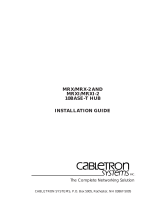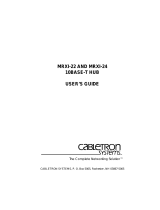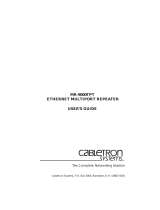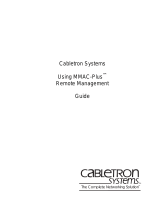Page is loading ...

MRXI/LM
LOCAL MANAGEMENT FOR THE
MRXI/MRXI-2
ETHERNET 10BASE-T HUB
USER'S GUIDE
CABLETRON SYSTEMS, P. O. Box 5005, Rochester, NH 03867-0505

NOTICE
i
NOTICE
Cabletron Systems reserves the right to make changes in specifications
and other information contained in this document without prior notice.
The reader should in all cases consult Cabletron Systems to determine
whether any such changes have been made.
The hardware, firmware, or software described in this manual is
subject to change without notice.
IN NO EVENT SHALL CABLETRON SYSTEMS BE LIABLE FOR
ANY INCIDENTAL, INDIRECT, SPECIAL, OR CONSEQUENTIAL
DAMAGES WHATSOEVER (INCLUDING BUT NOT LIMITED TO
LOST PROFITS) ARISING OUT OF OR RELATED TO THIS
MANUAL OR THE INFORMATION CONTAINED IN IT, EVEN IF
CABLETRON SYSTEMS HAS BEEN ADVISED OF, KNOWN, OR
SHOULD HAVE KNOWN, THE POSSIBILITY OF SUCH DAMAGES.
© Copyright November 1991 by:
Cabletron Systems Inc.
P.O. Box 5005, Rochester, NH 03867-0505
All Rights Reserved
Printed in the United States of America
Order Number: 9030327-01 November 91
MRXI
,
REMOTE LANVIEW/Windows
, and
SPECTRUM
are
trademarks of Cabletron Systems Inc.
DEC
,
VT200
, and
VT300
are trademarks of Digital Equipment
Corporation.
Ethernet
is a trademark of Xerox Corporation.

NOTICE
ii
FCC NOTICE
This device complies with Part 15 of FCC rules. Operation is subject to
the following two conditions: (1) this device may not cause harmful
interference, and (2) this device must accept any interference received,
including interference that may cause undesired operation.
NOTE:
This equipment has been tested and found to comply with the
limits for a Class A digital device, pursuant to Part 15 of FCC Rules.
These limits are designed to provide reasonable protection against
harmful interference when the equipment is operated in a commercial
environment. This equipment uses, generates, and can radiate radio
frequency energy and if not installed in accordance with the operator’s
manual, may cause harmful interference to radio communications.
Operation of this equipment in a residential area is likely to cause
interference in which case the user will be required at his own expense
to correct the interference.
If this equipment does cause interference to radio or television, which
can be determined by turning the equipment off and on, the user is
encouraged to try to correct the interference by one or more of the
following measures:
• Re-orient the receiving antenna.
• Relocate the equipment with respect to the receiving antenna.
• Move the equipment away from the receiver.
• Plug the equipment into a different outlet so that the
equipment and the receiver are on different branch circuits.
If necessary, the user should consult the dealer or an experienced
radio/ television technician for additional suggestions. The user may
find the following booklet prepared by the Federal Communication
Commission helpful:
“How to Identify and Resolve Radio TV Interference Problems”
This booklet is available from the U.S. Government Printing Office,
Washington D.C. 20402 - Stock No. 004-000-00345-4.

CONTENTS
iii
CONTENTS
CHAPTER 1 INTRODUCTION
1.1 Using This Manual........................................................................1-1
1.2 The MRXI ......................................................................................1-2
1.3 MRXI/LM.......................................................................................1-2
1.4 Remote LANVIEW/Windows .......................................................1-3
1.5 Related Manuals ...........................................................................1-3
1.6 Getting Help..................................................................................1-3
CHAPTER 2 ATTACHING THE CONSOLE
2.1 Local Management Console..........................................................2-1
2.2 Console Cable Configuration........................................................2-3
CHAPTER 3 GETTING STARTED
3.1 Using The Management Keyboard...............................................3-1
3.2 Understanding The Screens And Commands..............................3-2
3.3 MRXI/LM Screens.........................................................................3-2
3.4 Accessing Local Management via Terminal................................3-3
3.5 Accessing Local Management via Modem ...................................3-6
3.5.1 Cable Configuration............................................................3-6
3.5.2 Accessing Local Management ............................................3-6
CHAPTER 4 USING THE DEVICE/PORT
INFORMATION SCREEN
.....................................4-1
CHAPTER 5 USING COMMUNITY NAMES
.............................5-1
CHAPTER 6 MRXI/LM MESSAGES
............................................6-1

CONTENTS
iv

INTRODUCTION
Page 1-1
CHAPTER 1
INTRODUCTION
Welcome to Cabletron Systems
MRXI/LM Local Management for
the Cabletron Systems MRXI 10BASE-T HUB User's Manual.
This manual serves as a simple reference guide for using MRXI/LM™,
providing information to help you configure the MRXI™ and MRXI-2
and, if necessary, diagnose problems with your network.
NOTE:
This manual covers both the MRXI and MRXI-2. The two units
are functionally identical. The MRXI provides connections for ports 1
through 12 via a 50 pin Champ connector, while the MRXI-2 provides
twelve RJ-45 connectors. Throughout this manual the term MRXI is
used to cover both units unless otherwise specified.
1.1 USING THIS MANUAL
Read through this manual to become familiar with its contents and to
gain an understanding of the features and capabilities of MRXI/LM. A
general working knowledge of Ethernet networks and the IEEE 802.3
standard is necessary for interpreting and using MRXI/LM.
Chapter 1,
Introduction,
outlines the contents of this manual, briefly
describes features and functions performed by the Hub and MRXI/LM,
and concludes with a list of related manuals.
Chapter 2,
Attaching the Console
, describes terminal
characteristics, connecting console cabling, and configuring the
management console.
Chapter 3,
Getting Started,
describes the initial steps required to
access MRXI/LM. It describes each of the screens and the available
commands.
Chapter4,
Using the Device/Board/Port Counters Screen
,
describes the status and statistics information available for the MRXI.
Chapter 5,
Using Community Names
, describes entering and using
a community names table.
Chapter 6,
MRXI/LM Messages
, explains messages that can appear
at the top of the MRXI/LM terminal display.

INTRODUCTION
Page 1-2
1.2 THE MRXI
The MRXI 10BASE-T HUB and MRXI-2 10BASE-T HUB are 10BASE-
T and 802.3 compliant repeaters that allows expansion of existing
802.3 networks using a variety of media. The two hubs are identical
except for the physical connections for ports 1 through 12. The MRXI is
equipped with a 50 pin Champ connector, while the MRXI-2 provides
twelve RJ-45 connectors. The MRXI supports out-of-band and in-band
Simple Network Management Protocol (SNMP) compliant network
management. Out-of-band management for the MRXI is provided by
MRXI/LM. The MRXI is supported by several in-band network
management tools including: Cabletron Systems Remote LANVIEW/
Windows™, and SPECTRUM™.
1.3 THE MRXI/LM
The MRXI/LM is a menu driven, integrated network management tool
that permits management and control of the MRXI. MRXI/LM can be
used to:
• Display current MRXI status and statistics for the MRXI
network ports
• Define community names and access privileges
• Diagnose network problems.
The MRXI is an SNMP compliant device that permits setting
community names for your MRXI. The Community Names feature
serves two purposes:
• As a security feature that defines access privileges for SNMP
requests from SNMP management stations
• Community names let you to designate the network
management workstations that will receive alarms from the
MRXI.
You can access MRXI/LM through a management terminal connected
to the 9-pin Console port on the rear panel of the MRXI. The console
port supports a Digital Equipment Corporation, VT200™ or VT300™
series terminals or PC emulation of the VT200 or VT300 terminals.

INTRODUCTION
Page 1-3
1.4 REMOTE LANVIEW/WINDOWS
MRXI/LM provides the foundation for Remote LANVIEW/Windows,
Cabletron Systems Remote Network Control Management Software
package (This package can be purchased separately from Cabletron
Systems.). Remote LANVIEW/Windows allows you to control and
manage multiple MRXIs from a single Ethernet workstation. With
Remote LANVIEW/Windows, you can view statistics for your MRXI,
both numerically and graphically, using dynamic bar and pie charts
and
performance graphs. You can also enable a statistics logging and
reporting function that will log MRXI statistics to a report file for
future reference.
For more information on using Remote LANVIEW/Windows with the
MRXI, consult the Cabletron Systems
Remote LANVIEW/Windows
User Manuals
,
or call Cabletron Systems at (603) 332-9400.
1.5 RELATED MANUALS
The following manual should be used to supplement the procedures
and other technical data provided in this manual. The procedures
contained in this manual will be referenced where appropriate, but will
not be repeated in this manual.
Cabletron Systems
MRX/MRXI 10BASE-T HUB Installation Guide
1.6 GETTING HELP
If you need additional support related to Cabletron Systems MRXI/LM,
or if you have any questions, comments, or suggestions concerning this
manual, contact Cabletron Systems Technical Support at:
Cabletron Systems
P.O. Box 5005
Rochester, NH 03867-0505
Phone: (603) 332-9400

INTRODUCTION
Page 1-4

ATTACHING THE CONSOLE
Page 2-1
CHAPTER 2
ATTACHING THE CONSOLE
This chapter describes information on the characteristics of supported
terminals, configuring the management console and connecting the
console cabling.
2.1 LOCAL MANAGEMENT CONSOLE
MRXI/LM is accessed by attaching a management console at the DB-9
CONSOLE port on the rear panel of the MRXI (see Figure 2-1). The
console connection supports a Digital Equipment Corporation VT200™
or VT300™ series terminal or PC emulation of one of these terminals.
Figure 2-1. Management Console Connection
Table 2-1 lists the setup requirements for the local management
console. If your terminal is a Digital Equipment Corporation VT200™
or VT300™ series terminal, press
F3
to access the Setup Directory. If
you have a terminal emulation of the Digital Equipment terminals,
refer to your equipment user manual for setup procedures.
MRXI
10BASE-T
HUB
A
MANAGEMENT
TERMINAL
CONSOLE
CABLE
DB-9
CONSOLE PORT

ATTACHING THE CONSOLE
Page 2-2
Table 2-1. Terminal Setup Requirements

ATTACHING THE CONSOLE
Page 2-3
Menu Function Selection
Display Columns 80 Columns
Setup: Controls Interpret Controls
Auto Wrap No Auto Wrap
Text Cursor No Cursor
General Mode 7 Bit Control
Setup: (VT220) VT200
(VT320) VT300
Cursor Keys Normal Cursor
Keys
Communications
Setup: Transmit Transmit = 9600
Receive Receive = Transmit
XOFF any option
Bits, Parity 8 Bits, No Parity
Stop Bit 1 Stop Bit
Local Echo No Local Echo
Port EIA Port, Data Leads
Only
(VT220) EIA Port,
Data Leads only
(VT320) DEC-423,
Data Leads only
Transmit any option
Auto Answerback No Auto Answerback
(VT-320)
Keyboard Keys Typewriter Keys
Setup: Auto Repeat any option
Keyclick any option
Margin Bell Margin Bell
Warning Bell Warning Bell
Auto Answerback No Auto Answerback
(VT-220)

ATTACHING THE CONSOLE
Page 2-4
2.2 CONSOLE CABLE CONFIGURATION
A single female DB-9 receptacle provides a Console interface to the
management terminal. Depending on your specific terminal, one of two
cable configurations (9 pin to 25 pin or 9 pin to 9 pin) is used for the
connection to the MRXI Console port. Figure 2-2 shows the pinout for
both cables.
Figure 2-2. Console Cable Pinouts
Connect the console to the MRXI as follows:
1. Attach the male 9-pin connector to the CONSOLE port on the rear
of the MRXI.
2. Attach the female end (25-pin or 9-pin, as applicable) to the COMM
port on the terminal.
2
3
5
7
8
CONSOLE PORT LOCAL MANAGENT
CONSOLE
TRANSMIT
RECEIVE
RECEIVE
TRANSMIT
REQUEST TO SEND
CLEAR TO SEND
SIGNAL GROUND
REQUEST TO SEND
CLEAR TO SEND
S
IGNAL GROUND
9 PIN TO 9 PIN
CABLE
MALE - DB-9
(9-Pin Connector)
2
3
5
7
8
2
3
5
7
TRANSMIT
RECEIVE
RECEIVE
TRANSMIT
REQUEST TO SEND
CLEAR TO SEND
SIGNAL GROUND
SIGNAL GROUND
9 PIN TO 25 PIN
CABLE
FEMALE - 25 Pin
"D" Shell Connector
20 DATA TERMINAL READY
MALE - DB-9
(9-Pin Connector)
FEMALE - DB-9
(9-Pin Connector)
2
3
5
7
8
C
LEAR TO SEND

ATTACHING THE CONSOLE
Page 2-5

ATTACHING THE CONSOLE
Page 2-6

GETTING STARTED
Page 3-1
CHAPTER 3
GETTING STARTED
This chapter explains the conventions used by this manual to describe
each of the screens and commands available with MRXI/LM. It also
describes using the keyboard and the initial steps required to access
MRXI/LM.
3.1 USING THE MANAGEMENT KEYBOARD
The MRXI/LM screens are arranged with pertinent network
information filling much of the display area and several menu
selections across the bottom. To select a menu option or alter a field,
use the keyboard arrows (up, down, left, and right) to highlight the
desired item. Only fields that can be changed can be highlighted.
Incorrect entries (field value exceeded, etc.) are blocked and result in
an appropriate error message (refer to Chapter 6,
MRXI/LM
Messages
).
To make a menu selection:
1. Highlight the menu selection
2. Press
Return
To alter a field:
1. Highlight the desired field
2. Enter the new information
3. Press
Return
To toggle a field (select the alternative selection for a field):
1. Highlight the desired field
2. Press
Return
• The TAB key performs the same function as the right arrow.
• Backspace permits correction of entries.

GETTING STARTED
Page 3-2
• The RETURN command menu selection takes you back to the
previous screen.
3.2 UNDERSTANDING THE SCREENS AND COMMANDS
The hub and local management are controlled by entering parameters
directly into the fields presented on the terminal display and by
selecting commands from menus presented at the bottom of each
display screen. The information in this manual covers all of the
available display screens and is presented using the following format
conventions:
• Screen formats are illustrated and each field is described
within the text.
a. Field titles for fields that can be altered via the terminal
keyboard are shown underlined.
b. When a default value exists for an entry, the default value
appears in italics in the screen illustration and the default
also appears in parentheses and italics within the text
description of the field.
• COMMANDS appear in UPPER CASE in the screen
illustrations and in the text.
3.3 MRXI/LM SCREENS
The MRXI/LM provides interactive screens that let you alter
information and select MRXI/LM functions from a series of
management screens. Figure 3-1 shows the paths between screens.

GETTING STARTED
Page 3-3
Figure 3-1. MRXI/LM Screens
3.4 ACCESSING LOCAL MANAGEMENT VIA TERMINAL
To use MRXI/LM, the console must be connected as described in
Chapter 2,
Attaching the Console
. To access MRXI/LM:
1. If not already powered on, power on the MRXI.
2. Turn on power to the terminal. After a brief (approximately 5
seconds) warmup, the Password Screen appears (see Figure 3-2).
3. If you are not using the password feature of MRXI/LM or if you
have not yet applied your own password, press Return.
If you have applied a password known only to you, enter that
password now, then press Return.
PASSWORD SCREEN
MRXI SNMP LOCAL MANAGEMENT
MAIN
COMMUNITY NAMES
RETURN
SAVE
DEVICE/PORT INFORMATION SCREEN
ENABLE PORT
ENABLE ALL PORTS
DISABLE ALL PORTS
EXIT
SAVE
PORT n
DISABLE PORT
RESET COUNTERS
COMMUNITY NAMES

GETTING STARTED
Page 3-4
When you enter the correct password, a MRXI SNMP Local
Management Screen is displayed, indicating that MRXI/LM is
ready for operation (see Figure 3-3). The menu command MAIN is
highlighted.
If an incorrect or invalid password is entered, the password prompt
remains on the screen, allowing you to enter the correct password.
4. Press Return to display the Device/Port Information Screen (see
Figure 3-4). The Device/Port Information Screen serves as the
main screen for MRXI/LM.
MRXI/LM is now ready for operation.
Figure 3-2. Password Screen
Enter Password:

GETTING STARTED
Page 3-5
Figure 3-3. MRXI SNMP Local Management Screen
Figure 3-4. Device/Port Information Screen
Cabletron Systems Incorporated
P.O. Box 5005 Rochester NH 03867-5005 U.S.A.
(603) 332-9400
MRXI SNMP LOCAL MANAGEMENT
V
ers
i
on
X
.
XX
(c) Copyright Cabletron Systems, Inc. 1991
MAIN
Device/Port Information
Device Name:
SAVE RESET COUNTERSEXIT
Device Port 2
1619586
0
0
MRXI
Ethernet Address:
Set IP Address:
00-00-1d-00-05-48
34.141.3.14
Packets:
Receive Collisions:
Transmit Collisions:
628104
0
0
Device Ports On:
Device Ports Off:
Port Media Type:
Port Administrative Status:
Port Segmentation Status:
Port Link Status:
12
2
10BASE-T
On
On
NLNK
PORT 2
ENABLE PORT DISABLE PORT DISABLE ALL PORTSENABLE ALL PORTS
COMMUNITY NAMES
Set Modem Baud Rate: 9600
/










